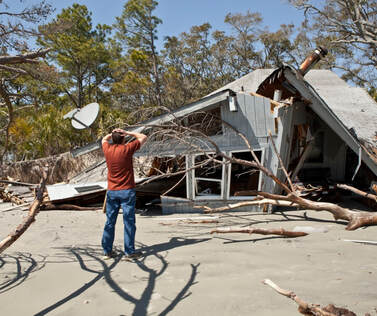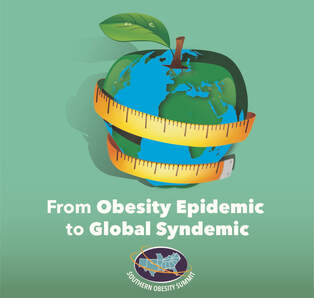
Kenneth D. Smith, PhD
Senior Public Health Research Analyst
Director, Southern Obesity Summit
Texas Health Institute
Kenneth D. Smith, PhD
Senior Public Health Research Analyst
Director, Southern Obesity Summit
Texas Health Institute
Building Healthy, Climate-Resilient Communities
|
Seeing the Bahamas reduced to rubble gave me flashbacks and reminded me that climate change augurs more frequent and more devastating hurricanes like Dorian. If you live in a hurricane zone like me, losing it all is a real and ever-present threat. Three years ago, Hurricane Harvey touched down in Texas. I was trapped in Austin but obviously worried about my house in Galveston, the site of America’s deadliest natural disaster. While Houston was inundated with torrential rain, my neighbors had assured me that Galveston was unaffected. The hurricane circled back two days later and flooded Galveston. By the time I got home, everything was basically back to normal. However, Houston and other parts of Texas were not spared.
Houston has since bounced back, but the trauma some people experienced will reverberate for some time. A very heart-wrenching example is what happened to a child from Northwest Houston suffering from obesity and T2 diabetes. She was from a family of limited resources who lost everything in the flood. While she and her family were being rescued, her rescue boat sideswiped another boat. Because her hands were clutched ahold the side of her rescue boat, the other boat crushed and severed some of her fingers. Prior to the flood, the girl had participated in an exemplary nutrition and exercise program offered by a local community-based healthcare center. As part of its obesity prevention initiative, the center was working to improve access to affordable produce and increase opportunities for physical activities for both patients and residents in the service area. Both the child, her family, and their neighbors would have benefited from those community transformation efforts, but the flood put those efforts on hold. One way or another, everyone felt the aftermath of Harvey. Many of the healthcare center’s patients suffered tremendously, but the center’s staff was affected as well. A promotora who worked for the healthcare center wept as she relayed the trauma the girl experienced. Healthcare center staff not directly impacted by Harvey, nevertheless, had family and friends who may have lost everything. After the floods, the healthcare center had to delay their community transformation efforts for almost three years. This setback illustrates why community prevention practitioners, advocates, and funders need to incorporate climate change in the design of obesity prevention initiatives. Consider the potential influence of climate change on obesity disparities. Households with food insecurity are more likely to purchase lower-priced, highly-processed food that contributes to obesity. Extreme weather events associated with climate change—drought, flooding, wildfires, and killer heat—all disrupt agricultural production, leading to reduced supply and higher prices for healthy produce. After extreme weather events, families of limited means are even more likely to have food insecurity and purchase unhealthy food. Unless this is addressed during the recovery phase, obesity disparities are likely to widen after an extreme weather event. Community-level obesity prevention, joined with climate change mitigation and adaptation strategies, can be a win-win solution to multiple public health crises. According to a recent UN report on Climate Change and Land, reforestation, regenerative agriculture, and land conservation are strategies that can mitigate climate change while addressing under-nutrition. For example, by pulling carbon from the atmosphere into the soil, regenerative agriculture is a climate change mitigation strategy. At the same time, support for sustainable farmers using sustainable agriculture practices is important for building local, resilient food systems that ensure the availability of healthy, affordable produce after extreme weather events. This, in turn, would help reduce food insecurity and its potential impact on obesity disparities. These actions are not beyond the scope of existing community-level obesity prevention strategies. Some clinics are partnering with local farmers to provide fresh produce to fill food prescriptions. The next logical step is to use local procurement policies to support local, sustainable agriculture. Public health is already involved in zoning and urban design strategies to improve neighborhood walkability while reducing CO2 emissions. It’s only a small step for public health to advocate for conserving wetlands from over-development, a key factor in the destructiveness of Hurricane Harvey. Practitioners, policymakers, and advocates for obesity prevention merely need to widen their scope of concern. It’s not a stretch to see them ally with climate change activists. The upcoming 13th Annual Southern Obesity Summit offers an opportunity for these groups to think more expansively about how to scale-up their work for collective, global impact. If you have not already done so, register today. |
The Best Solutions Solve Multiple Problems
|
I’m a veteran of the food wars of the late 2000s. Before coming to Texas Health Institute, I worked as Director of Chronic Disease Prevention in Philadelphia. Like other big cities, Philadelphia was the leading edge in the movement to prevent chronic disease through policy, systems, and environmental change. After the Philadelphia City Council passed an ordinance in 2007 prohibiting trans fat in prepared foods (a major victory in the ongoing battle to reduce heart disease and bad cholesterol), the council was debating a new bill that would exempt nearly all establishments where people consume those trans fatty foods—a de facto retreat.
I was sent by the commissioner to give testimony about the population health benefits of the original proposal in the face of threats by restaurant owners allied with certain DC think tanks. I remember one commercial before the hearings featured an angry chef injecting a huge donut with a large IV full of some gross mixture of sugar and lard. “I’m going to give them a piece of my mind,” he said on the TV news. Unfortunately, it was a defeat. As a result, another bill that would have required all restaurants to display calories on menus and menu boards died in committee. There was no appetite for another public health bill. At the time, I convened a chronic disease consortium that supported the concept of menu labeling. Consortium members often disagreed on plans and priorities. The grassroots community expressed great concern about sodium, as many people in their neighborhoods struggled with high blood pressure. Clinical partners and professional organizations focusing on childhood overweight and diabetes recommended including grams of carbs and fats, including trans fats. But everyone agreed on one thing. Transparent and easily available information was a common solution to the trend of families increasingly eating out. It empowered individuals and families to make healthy choices. The consortium settled on a simple set of four items to include on menus and menu boards: calories, sodium, carbs, and fats. They sent a message to the original bill sponsor saying they would stand by her, if she included those four items in a new bill. It worked! The Philadelphia City Council passed the most comprehensive menu labeling ordinance in the country by an overwhelming margin. It passed with strong support from a variety of partners, particularly from grassroots community groups. This case study shows the importance of public health advocates moving beyond their parochial interests to find common ground and work towards collective impact. In many ways, obesity prevention has a similar opportunity for collective impact. The newly released report by the UN Intergovernmental Panel on Climate Change is elevating the need to change land use and food production systems to avert catastrophic climate change. When obesity is seen as a condition arising, in part, from an out-of-control global food system, obesity prevention advocates can find common ground with advocates working to address climate change and undernutrition. The Southern Obesity Summit provides a pathway for collective impact. SOS participants will have a dialogue about how to join up their obesity prevention efforts with those from other sectors. It’s an opportunity for deep collaboration to improve human and planetary health. If you want to be a part of that dialogue, be sure to register. |
From Obesity Epidemic to Global Syndemic
|
The United States is in the middle of an obesity epidemic with no end in sight. In seven states, one in three Americans are obese; and, according to the World Health Organization, obesity has tripled nation-wide since 1975. This epidemic is now considered a national security threat. You can talk about obesity in the same sentence as North Korean nuclear weapons. How’s that for scary?
The World Health Organization recognized the global nature of obesity as far back as 1997. With one billion overweight adults and more than 300 million obese individuals in both rich and poor countries, we’re really talking about a global epidemic—also known as a pandemic. What on earth is causing everyone to gain weight at the same time? It can’t be a coincidence. Did the whole world decide, simultaneously, to adopt the Homer Simpson diet? It’s a peculiar phenomenon given the fact that malnutrition, hunger, and food insecurity tend to co-occur in the same regions and populations. This seeming paradox points to different ways of thinking about how to reverse the obesity pandemic beyond conventional, individualistic approaches that focus on energy balance. The Lancet, a highly esteemed medical journal from the UK, released a special issue in January naming obesity as part of a global syndemic of obesity, undernutrition, and climate change. A syndemic is a clustering of diseases that interact at social, biological, and psychological levels. More important, the social and demographic factors often drive the emergence of a syndemic in disadvantaged populations. The existence of a syndemic will make traditional approaches to targeting an individual disease ineffective. Researchers have uncovered the following syndemics: substance abuse, violence and AIDS, AIDS and STDs, and opioid overdoses and Hepatitis C. We can now add obesity, hunger, and climate change to this growing list. If obesity is part of a global syndemic, then reversing the pandemic of obesity requires new thinking, new partners, and new approaches. The first step is to recognize and understand the complex systems and social forces that are driving the syndemic. The upcoming Southern Obesity Summit will provide an opportunity for obesity prevention practitioners and policy makers to reflect on their work through a systems lens, and explore the implications of the global syndemic on future collaborative action. |
Think About It: Systems Approaches to Obesity Prevention
|
The theme for the 13th Annual Southern Obesity Summit is “Improving Systems to Promote Healthy People and Resilient Communities.” It sounds great, but what is it really all about? What’s different about this year?
The main difference is about “Improving Systems.” Almost 10 years ago, the National Academy of Science recognized the importance of taking a systems perspective to address the obesity epidemic. Since then there have been a number of books on systems approaches to health and obesity. The CDC and WHO have fostered learning about systems thinking. Some are advocating incorporating systems science in Healthy People 2030. Just to be clear, this year’s SOS is not a systems thinking conference. It’s still about obesity prevention in the south. It will still have 16 state teams meeting to discuss coordinated regional action. Attendees from prior Summits should feel right at home in Oklahoma City. However, our plenary sessions will offer opportunities to learn about obesity prevention through a systems thinking lens. This may be the first time many attendees will be exposed to systems thinking. Because systems approaches to obesity prevention involves collaboration across sectors and disciplines, we created tracks that align with the systems that drive the obesity epidemic. We’re increasing our outreach to maximize participation by nontraditional attendees such as prevention entrepreneurs. While abstracts can focus on new tools, resources, or interventions, we are also interested in thought pieces and case studies that illustrate how systems phenomenon can thwart our best intentions. Stories that shed light on how to avoid delays and unintended consequences in designing and implementing obesity prevention interventions are especially welcome this year. Texas Health Institute recommends this approach because of the urgency we see to reboot obesity prevention efforts in the US. Obesity is a global phenomenon, and it is important for practitioners who work locally to understand the national and global context of the systems that drive obesity—systems that often limit the effectiveness of their work. Moreover, as noted in a recent Lancet report, the obesity pandemic is driven by the same systems that drive under-nutrition and climate change, two other global phenomena. By tying these three pandemics as a “syndemic” the Lancet authors link the work of obesity prevention to the concerns of those working to address global hunger and climate change. Obesity prevention needs all the allies it can get, especially since advocates are struggling to keep obesity at the top of policy makers’ agendas. Taking a systems approach to a global syndemic can strengthen our allies in the fight against obesity while improving our capacity to make a dent in a pandemic that no country has ever reversed. This year’s SOS is a baby step toward promoting a systems approach to obesity prevention at the regional level. We hope that some of the 400 attendees return to their states with a new vision and a stronger capacity to reverse obesity not just in the South, but in the world. SOS might be a baby step in that direction, but that is just enough for the US South to take the lead in a global epidemic. |




